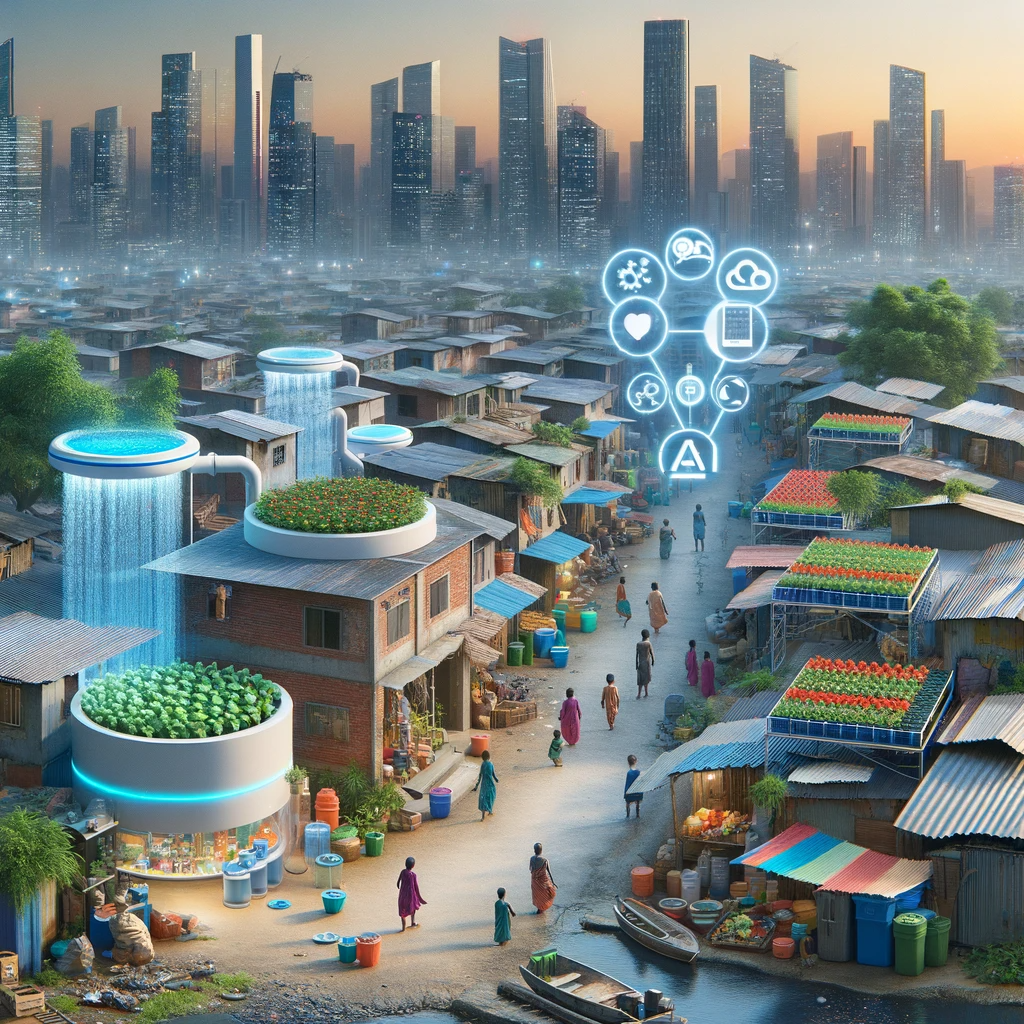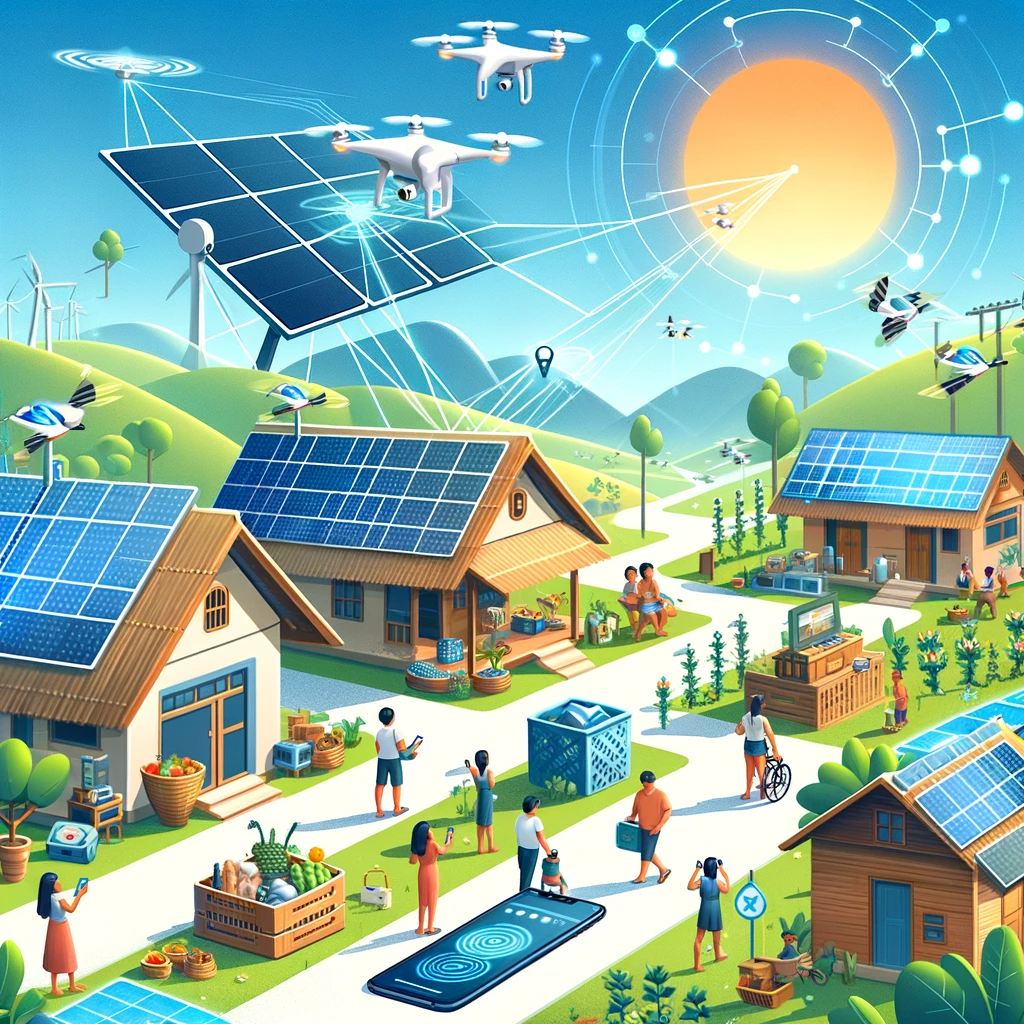The world is no stranger to the persistent, daunting challenge of global poverty. As the global community grapples with the intricate web of factors that perpetuate this crisis, an unlikely ally has emerged: Artificial Intelligence (AI). In the fight against global poverty, AI is proving to be a formidable force, offering innovative solutions that have the potential to reshape the future of poverty alleviation.
The specter of poverty casts a long shadow, affecting billions of lives across the globe. Access to basic necessities, such as food, clean water, healthcare, and education, remains an unmet dream for many. Yet, in this era of technological advancement, we stand at the precipice of a new dawn—one where AI technologies offer hope and tangible strategies for change.
This article embarks on a journey to explore the profound impact of AI in the battle against global poverty. It delves into the transformative possibilities that AI brings to the table, from economic modeling that illuminates the path forward to resource allocation that maximizes impact. We will also examine the role of AI in designing targeted aid programs that reach those who need it most.
As we delve into the realms of AI and poverty alleviation, we will not shy away from acknowledging the challenges and ethical considerations that accompany this technological journey. Questions of data privacy, algorithmic bias, and the equitable distribution of AI’s benefits demand thoughtful answers.
At the heart of this exploration lies the realization that AI has the potential to be a game-changer—an ally to governments, nonprofits, and communities striving to lift people out of poverty. It is a call to recognize the transformative power of technology and to harness it responsibly and ethically, forging a brighter future for those who have long lived in the shadows of poverty’s grasp.
AI in Economic Modeling
The integration of Artificial Intelligence (AI) in the fight against global poverty begins with its remarkable capability in economic modeling. AI’s proficiency in handling vast and intricate datasets has paved the way for more accurate, data-driven economic insights and predictions.
- Complex Data Analysis: AI-driven algorithms are adept at dissecting complex economic data, including factors such as income disparities, regional development, and global trade patterns. They can recognize hidden correlations and trends within these datasets, shedding light on the underlying causes of poverty.
- Forecasting and Scenario Analysis: Economic modeling powered by AI is not limited to historical data analysis. AI can forecast economic trends and simulate different scenarios, enabling policymakers and researchers to assess the potential impact of various poverty alleviation strategies. This capability is invaluable for making informed decisions and crafting effective policies.
- Policy Design and Evaluation: AI-enhanced economic models can assist governments and organizations in designing poverty reduction policies. By simulating the outcomes of different policy interventions, AI provides insights into which strategies are most likely to succeed in specific contexts. This approach enhances the precision and effectiveness of poverty alleviation efforts.
- Case Study: Poverty Prediction Models: AI has enabled the development of poverty prediction models that identify vulnerable populations. These models combine socio-economic data, geographic information, and machine learning algorithms to pinpoint areas where poverty is most prevalent. Such targeted insights guide the allocation of resources and aid to regions in need.

Resource Allocation and Optimization
AI’s potential in addressing global poverty becomes even more pronounced in the realm of resource allocation and optimization. The efficient distribution of limited resources is a critical component of effective poverty alleviation strategies, and AI excels in this regard.
- Optimizing Aid Distribution: AI algorithms can optimize the allocation of resources, such as food, healthcare, and education, to maximize their impact. By analyzing local needs, demographic data, and supply chain logistics, AI can ensure that aid reaches those who need it most.
- Precision Targeting: AI-driven resource allocation goes beyond geographical considerations. It can identify specific households or individuals within a community who are most vulnerable to poverty. This level of precision enables aid organizations to tailor their interventions, ensuring that support is directed where it will have the most significant effect.
- Efficiency in Disaster Response: In times of natural disasters or humanitarian crises, AI can play a vital role in rapid resource deployment. Predictive analytics and real-time data analysis enable AI systems to anticipate disaster impacts and pre-position resources for immediate response.
- Case Study: AI-Optimized Food Distribution: In regions prone to food insecurity, AI is used to optimize the distribution of food aid. Algorithms consider factors such as nutritional needs, transportation routes, and local market dynamics to ensure that food reaches malnourished communities efficiently.
Targeted Aid Programs
AI’s transformative potential in addressing global poverty extends to the design and implementation of targeted aid programs. By harnessing the power of AI, organizations can ensure that their aid efforts are not only effective but also tailored to the specific needs of impoverished communities.
- Data-Driven Needs Assessment: AI utilizes vast datasets to conduct comprehensive needs assessments. It identifies the unique challenges faced by impoverished communities, taking into account factors like healthcare access, education levels, employment opportunities, and more.
- Customized Aid Solutions: Armed with precise data, organizations can design aid programs that are customized to address the specific challenges identified. Whether it’s improving access to clean water, healthcare, or education, AI-driven aid programs can be tailored to deliver maximum impact.
- Real-Time Monitoring and Adaptation: AI’s real-time monitoring capabilities ensure that aid programs remain responsive to evolving conditions on the ground. By constantly analyzing data, AI can detect emerging needs and adjust aid strategies accordingly.
- Case Study: AI-Powered Healthcare Outreach: In remote or underserved areas, AI-driven healthcare outreach programs use data to identify individuals at risk of preventable diseases. These programs provide targeted healthcare interventions and education, ultimately improving health outcomes in vulnerable communities.
As we explore the potential of AI in addressing global poverty, it becomes clear that the technology is not merely a tool but a catalyst for more effective, data-driven, and personalized poverty alleviation efforts. The following sections will delve into the challenges and ethical considerations of AI in this context and highlight real-world success stories that illustrate AI’s tangible impact on impoverished communities.
Challenges and Ethical Considerations
As AI takes center stage in the fight against global poverty, it is imperative to acknowledge and address the challenges and ethical considerations that accompany its deployment.
- Data Privacy and Security: The collection and utilization of vast amounts of data for AI-driven poverty alleviation programs raise concerns about data privacy and security. Safeguarding sensitive information and ensuring it is not misused is paramount.
- Algorithmic Bias: AI algorithms can inherit biases present in training data, potentially perpetuating inequalities and discrimination. Ensuring fairness and impartiality in AI models is an ongoing challenge.
- Equitable Access: The digital divide and unequal access to AI technologies can exacerbate existing disparities. Ensuring that AI-driven poverty solutions are accessible to all, including marginalized and remote communities, is a critical ethical consideration.
- Human Oversight: While AI can enhance decision-making, it should not replace human judgment entirely. Maintaining a balance between AI automation and human oversight is essential to avoid unintended consequences.
- Accountability and Transparency: The opacity of AI algorithms can be a barrier to accountability. Establishing transparency mechanisms and clear lines of responsibility is essential to maintain trust in AI-powered poverty alleviation efforts.
Real-World Impact and Success Stories
The transformative potential of AI in addressing global poverty is not merely theoretical—it is already making a significant impact on impoverished communities around the world.
- AI in Healthcare Access: AI-powered diagnostic tools are enabling remote and underserved communities to access healthcare services. For example, AI-driven telemedicine platforms provide real-time medical advice to patients in remote regions, improving health outcomes.
- Agricultural Advancements: AI-based precision agriculture technologies are helping smallholder farmers increase crop yields and income. AI algorithms analyze soil conditions, weather data, and crop health, offering actionable insights to farmers.
- Financial Inclusion: AI-driven fintech solutions are expanding access to financial services for the unbanked and underbanked populations. Mobile banking and AI-powered credit scoring enable individuals to build financial stability.
- Education Enhancement: AI-powered educational platforms offer personalized learning experiences, bridging gaps in education access. Students in remote areas can access quality educational content and receive tailored support.
- Disaster Response: AI plays a crucial role in disaster preparedness and response. Predictive analytics and real-time monitoring enable timely evacuation, resource allocation, and relief efforts during emergencies.
Future Possibilities and Collaborations
The future of AI in the fight against global poverty holds immense promise and potential for collaboration among governments, nonprofits, tech companies, and AI experts.
- AI for Sustainable Development Goals: Collaborations that harness AI’s capabilities can contribute significantly to achieving the United Nations Sustainable Development Goals (SDGs). AI-driven solutions can address poverty (SDG 1), health (SDG 3), education (SDG 4), and more.
- Public-Private Partnerships: Governments, philanthropic organizations, and tech companies can form partnerships to fund and implement AI-driven poverty alleviation initiatives. These collaborations can leverage the strengths of each sector for maximum impact.
- Capacity Building: Initiatives to build AI expertise within poverty-stricken regions can empower local communities to develop and manage AI-powered solutions tailored to their unique challenges.
- Ethical AI Standards: Establishing ethical guidelines and standards for AI deployment in poverty alleviation ensures responsible and equitable practices across the sector.

Conclusion
In conclusion, the synergy between AI and the fight against global poverty is a defining narrative of our time. As AI technologies continue to evolve and mature, their potential to transform the lives of the impoverished is undeniable. However, this potential comes with a responsibility to navigate the challenges and ethical considerations associated with AI deployment.
The real-world impact of AI in healthcare, agriculture, education, and disaster response demonstrates that AI is not a distant promise but a present reality. The success stories of AI-driven initiatives offer a glimpse into the transformative power of technology when harnessed for the greater good.
As we look to the future, the fight against global poverty must be a collective endeavor, where governments, organizations, and communities unite to leverage AI as a powerful tool for change. It is a call to action—an invitation to envision a world where AI stands as an ally in the relentless pursuit of a more equitable and poverty-free future.

